教科版四年级下册英语知识点归纳
教科版四年级下册英语复习知识点汇总
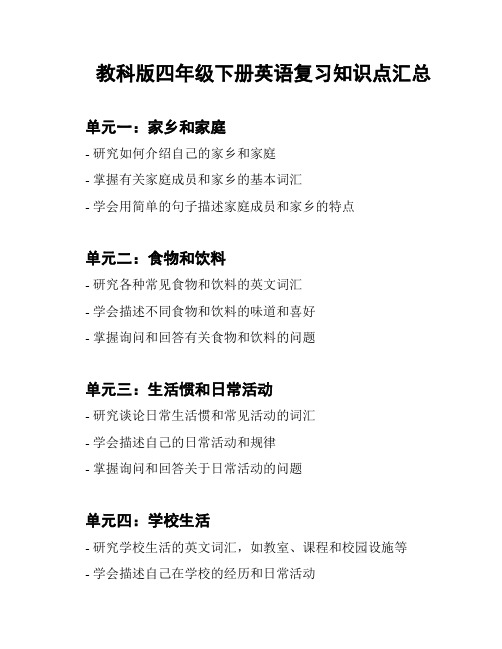
教科版四年级下册英语复习知识点汇总
单元一:家乡和家庭
- 研究如何介绍自己的家乡和家庭
- 掌握有关家庭成员和家乡的基本词汇
- 学会用简单的句子描述家庭成员和家乡的特点
单元二:食物和饮料
- 研究各种常见食物和饮料的英文词汇
- 学会描述不同食物和饮料的味道和喜好
- 掌握询问和回答有关食物和饮料的问题
单元三:生活惯和日常活动
- 研究谈论日常生活惯和常见活动的词汇
- 学会描述自己的日常活动和规律
- 掌握询问和回答关于日常活动的问题
单元四:学校生活
- 研究学校生活的英文词汇,如教室、课程和校园设施等
- 学会描述自己在学校的经历和日常活动
- 掌握询问和回答有关学校生活的问题
单元五:节日和庆祝活动
- 研究常见节日和庆祝活动的英文表达方式
- 掌握询问和回答有关节日和庆祝活动的问题- 学会用英文描述自己参与和组织的庆祝活动
单元六:动植物和自然环境
- 研究常见动植物的英文名称和特征
- 掌握描述动植物和自然环境的基本词汇和句子- 学会用英文描述自己对自然环境的保护和关心
单元七:人物和事物的比较
- 研究用英文比较人物和事物的方式
- 掌握用形容词和副词进行比较的句型
- 学会用英文进行人物和事物的比较和对比
单元八:旅行和交通工具
- 研究旅行和交通工具的英文词汇和表达方式- 掌握描述自己的旅行经历和交通方式的句子
- 学会用英文询问和回答有关旅行和交通的问题
以上是教科版四年级下册英语的复知识点汇总,希望能够帮助你更好地复和记忆这些内容。
四年级英语下册重点知识点总结

四年级英语下册重点知识点总结
四年级英语下册的重点知识点总结如下:
1. 时态动词:学习使用一般现在时、一般过去时和一般将来时来描述不同时间发生的动作。
掌握动词的基本形式和过去式,以及一般将来时的构成。
2. 句型转换:学会进行肯定句、否定句和问句的转换,掌握一般疑问句和特殊疑问句的构成。
3. 数字和计量词:学习数字的书写和发音,掌握基本的计量词,如:a few、a little、a lot of等。
4. 学校用语:掌握与学校相关的英语表达,如:教室、图书馆、操场等地方的名称,以及上课、做作业、考试等动作的描述。
5. 应急日常用语:学习一些日常英语用语,如:问候、道歉、请求帮助等,以便能够进行基本的交流和应对常见的情境。
6. 日常生活描述:学习如何用英语描述日常生活,如:描述自己的家庭、家人、爱好等。
掌握描述人物外貌、个性和能力的词汇。
7. 交通方式:学习描述不同交通工具的名称,如:车、飞机、船等,以及如何描述交通方式、交通工具的行驶方向和速度。
8. 天气和季节:学习描述天气状况和不同季节的英语表达,如:
晴天、阴天、下雨、夏天、秋天等。
9. 礼貌用语:学习基本的礼貌用语,如:谢谢、对不起、请等,以便能够与他人进行礼貌的交流。
以上是四年级英语下册的重点知识点总结,希望对你有帮助!。
2024年小学四年级英语下册知识点资料
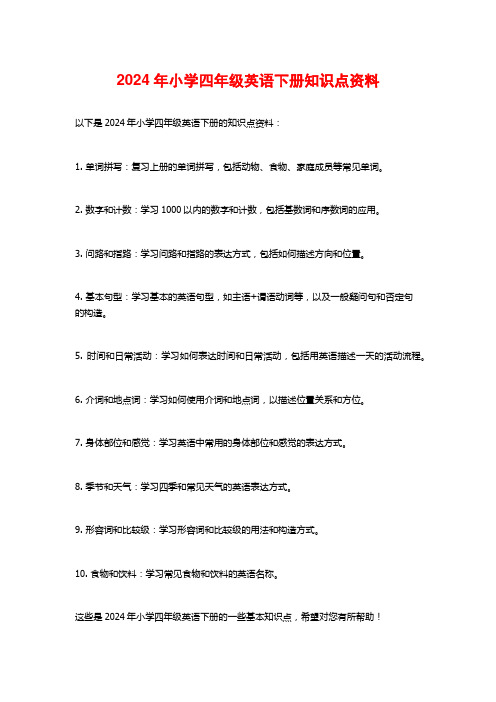
2024年小学四年级英语下册知识点资料
以下是2024年小学四年级英语下册的知识点资料:
1. 单词拼写:复习上册的单词拼写,包括动物、食物、家庭成员等常见单词。
2. 数字和计数:学习1000以内的数字和计数,包括基数词和序数词的应用。
3. 问路和指路:学习问路和指路的表达方式,包括如何描述方向和位置。
4. 基本句型:学习基本的英语句型,如主语+谓语动词等,以及一般疑问句和否定句
的构造。
5. 时间和日常活动:学习如何表达时间和日常活动,包括用英语描述一天的活动流程。
6. 介词和地点词:学习如何使用介词和地点词,以描述位置关系和方位。
7. 身体部位和感觉:学习英语中常用的身体部位和感觉的表达方式。
8. 季节和天气:学习四季和常见天气的英语表达方式。
9. 形容词和比较级:学习形容词和比较级的用法和构造方式。
10. 食物和饮料:学习常见食物和饮料的英语名称。
这些是2024年小学四年级英语下册的一些基本知识点,希望对您有所帮助!。
英语下册知识点四年级

英语下册知识点四年级英语作为一门语言学科,在小学四年级下册的学习中,学生需要掌握更多的词汇、语法结构以及基本的交际用语。
以下是四年级下册英语的一些重要知识点:词汇学习- 学习与日常生活相关的词汇,如家庭成员、日常活动、学校用品等。
- 掌握一些基本的动词,如play, eat, go, have等。
- 学习一些形容词和副词,如big, small, fast, slow等,以及它们的比较级和最高级形式。
语法结构- 学习使用一般现在时态来描述日常活动和习惯。
- 掌握名词复数形式的规则和不规则变化。
- 学习使用疑问句,如Is this your book? Can you swim?- 学习使用现在进行时态描述正在进行的动作。
基本交际用语- 学习自我介绍和询问个人信息,如My name is ..., How old are you?- 学习日常问候语,如Good morning, How are you?- 学习表达感谢和道歉,如Thank you, I'm sorry.- 学习简单的请求和提供帮助,如Can I help you? Sure, here you are.阅读理解- 通过阅读简单的英语故事或文章,理解基本的故事情节和主题。
- 学习识别和理解文章中的关键词和短语。
- 通过阅读练习,提高理解问题和回答问题的能力。
写作技能- 学习写简单的句子,如I like ..., She can ...- 练习写日记或小故事,描述一天的活动或想象中的事件。
- 学习基本的写作结构,如开头、中间和结尾。
听力理解- 通过听英语歌曲、故事或对话,提高听力理解能力。
- 学习在听力材料中识别关键词和理解大意。
- 练习听指令并做出相应的反应。
文化知识- 了解一些英语国家的节日和习俗,如圣诞节、复活节等。
- 学习一些简单的英语国家的历史和地理知识。
复习与练习- 定期复习所学内容,确保知识点的牢固掌握。
- 通过做练习题和模拟测试,检验学习效果。
Module3 Unit5 What day is it today(讲义)教科版英语四年级下册

广州四年级下册Unit 5单词周;星期今天为什么星期一星期二星期三星期四星期五星期六星期天Unit 5词组在星期四on . 最喜欢的一天.两节体育课two PE . 喜欢唱歌love .玩得开心have . 非常;十分very .Unit 5句型根据中文提示把句子补充完整。
1. day it ? (今天星期几?)2. Wednesday. (星期三)3. It’s day! (这是我最喜欢的一天。
)4. do you like ? (你为什么喜欢星期三?)5. Wednesday we two PE . (我们在星期三有两节体育课)6. favourite day is . (我最喜欢的一天是星期四)7. your favourite ? (你最喜欢星期几?)四年级下册Unit 5 要点:On+星期On Sundaylove+doing love singing love runningLove to do love doingLike to do like doing练一练:What day is it today ?Is it Monday today ?Is it Monday or Tuesday?Why do you like Monday ?What is your favourite day?What lessons do you have today?Do you have an English lesson on Tuesday?What time do you usually have dinner?Unit 5选词填空1.What do you usually do (at,in,on )Monday?2.I love (doing, do, does ) homework after school.3.We have (a,an, the) art lesson and a PE lesson on Tuesday.4. I often have five Chinese (lesson,class, lessons) in a week.5. I like (to play, plays, play ) with my friends.6. I get up at 7:30 _______ (at, in, on) the morning.7. We never go shopping ______ (at, in, on) the evening.8.He often plays football with his friends _______ (at, in, on) Sunday.知识考点【知识考点一】询问今天是星期几的句型:---What day is it today? ---It’s + 星期-- day it today? (今天是星期几?)-- . (星期一)问时间的相关句子: 1. 问时间点:-What’s the time? =?- It’s…2. 问时间段:-When do you…? -- From… to…【知识考点二】I like/ love… 我喜欢……否定句:I don’t like/love…一般疑问句:Do you like/love…?肯定回答:Yes, I do. 否定回答:No, I don’t.like和love后面只能跟名词或者动词的ing形式。
四年级下册英语 知识点

四年级下册英语知识点四年级下册英语教材主要包括以下几个单元:Unit 1: Let's Move! Unit 2: Pets Unit 3: A Fun Day! Unit 4: Our World Unit 5: Food Unit 6: My Family Unit 7: Five Senses Unit 8: Weather Unit 9: On the Farm Unit 10: Our Clothes Unit 11: Homes Unit 12: Jump for Joy!以下是各个单元的相关知识点参考内容:Unit 1: Let's Move!- 动词动作:run, walk, jump, skip, hop, swim, climb- 指示代词:this, that, these, those- 疑问词:what, where, when, who, why, how- 指示物体位置:behind, in front of, next to, between- 介词:in, on, under, behind, in front of, next to, betweenUnit 2: Pets- 动物名称:cat, dog, bird, fish, rabbit, hamster- 形容词描述:small, big, cute, furry, friendly- 询问及回答问题:Do you have any pets? Yes, I have a ______. No, I don't have any pets.- 宠物习性:eat, sleep, play, drinkUnit 3: A Fun Day!- 活动名称:ride a bike, play soccer, fly a kite, have a picnic, make a cake- 句型:I can ______. Let's _______.- 时间表达:morning, afternoon, evening- 情态动词can:表示能力或允许- 数词:first, second, third, fourth, fifthUnit 4: Our World- 地点名称:school, park, hospital, supermarket, library- 地点描述:big, small, busy, quiet, crowded- 询问及回答问题:Where do you go to play? I go to the__________.- 介词:at, to, in, on- 句型:I go to the ________ to _______.Unit 5: Food- 食物名称:apple, banana, rice, noodles, cake, cookies- 不可数名词:water, milk, juice, bread, butter, cheese- 形容词描述:sweet, sour, delicious, yummy, healthy- 询问及回答问题:Do you like ________? Yes, I do. No, I don't. - 句型:I like _________. I don't like _________.Unit 6: My Family- 家庭成员:grandpa, grandma, dad, mom, brother, sister- 人称代词:I, you, he, she, we, they- 外貌特征:tall, short, old, young, long hair, short hair- 家人关系:father - son, mother - daughter, grandfather - granddaughter- 句型:This is my _______. He/She is _______.Unit 7: Five Senses- 五官名称:eyes, ears, nose, mouth, hands- 动词动作:see, hear, smell, taste, touch- 形容词描述:big, small, loud, quiet, sweet, sour- 句型:I can ______ with my _______.Unit 8: Weather- 天气状况:sunny, windy, rainy, cloudy, snowy- 询问及回答问题:What's the weather like today? It's ________. - 季节名称:spring, summer, autumn, winter- 句型:It's _______ in _______.Unit 9: On the Farm- 牲畜名称:cow, sheep, pig, horse, chicken, duck- 动物生活环境:barn, pen, field- 动物行为:eat grass, run, swim, fly, lay eggs- 询问及回答问题:What can a _______ do? A ________ can_______.- 句型:Look at the _______ in the ________.Unit 10: Our Clothes- 衣物名称:hat, shirt, skirt, pants, shoes, socks- 颜色描述:red, blue, yellow, green, black, white- 季节穿着:coat, sweater, boots, sandals, sunglasses, raincoat- 询问及回答问题:What are you wearing today? I'm wearing a ________.- 句型:I like to wear ________.Unit 11: Homes- 房屋类型:house, apartment, villa, cabin, tent- 我的房间描述:big, small, tidy, messy, comfortable, cozy- 家具名称:bed, desk, chair, table, wardrobe, bookshelf- 询问及回答问题:What is in your room? There is a ________. - 句型:My house has ________.Unit 12: Jump for Joy!- 动词动作:jump, dance, sing, clap, hop, skip- 形容词描述:happy, sad, excited, tired- 表示情感:I am ________. It makes me ________.- 句型:I feel _______ when I _______.希望以上内容能够帮到你!。
四年级下册英语知识点汇总
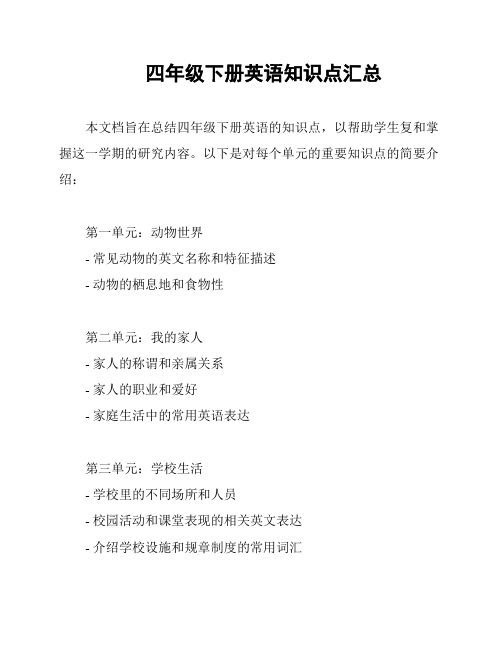
四年级下册英语知识点汇总
本文档旨在总结四年级下册英语的知识点,以帮助学生复和掌握这一学期的研究内容。
以下是对每个单元的重要知识点的简要介绍:
第一单元:动物世界
- 常见动物的英文名称和特征描述
- 动物的栖息地和食物性
第二单元:我的家人
- 家人的称谓和亲属关系
- 家人的职业和爱好
- 家庭生活中的常用英语表达
第三单元:学校生活
- 学校里的不同场所和人员
- 校园活动和课堂表现的相关英文表达
- 介绍学校设施和规章制度的常用词汇
第四单元:健康饮食
- 健康食物和垃圾食品的区别
- 饮食惯和健康生活的重要性
- 日常生活中的饮食建议和健康惯
第五单元:外出游玩
- 常见景点和旅游活动的英文表达- 描述天气状况和旅行计划的句型- 景点介绍和旅游交通方式的词汇
第六单元:时间和日期
- 基本的时间词汇和句型
- 询问和回答日期的表达方式
- 日常活动和研究计划的时间安排
第七单元:节日文化
- 常见节日和庆祝活动的英文名称- 对节日的描述和庆祝方式的表述- 介绍一些国际节日的历史和俗
第八单元:自然环境
- 常见的自然环境和地质现象词汇
- 描述自然景观和地理特征的句子
- 关于环境保护的基本知识和倡议
以上是四年级下册英语的知识点汇总,希望对同学们的学习有所帮助。
四年级英语下册重点知识点归纳
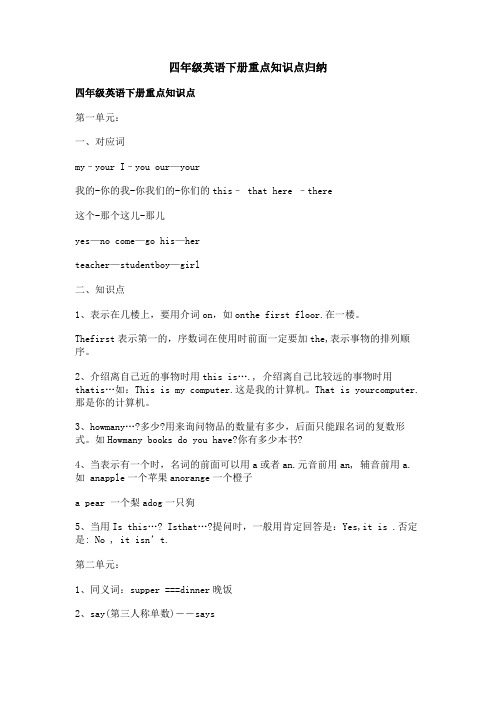
四年级英语下册重点知识点归纳四年级英语下册重点知识点第一单元:一、对应词my–your I–you our—your我的-你的我-你我们的-你们的this– that here –there这个-那个这儿-那儿yes—no come—go his—herteacher—studentboy—girl二、知识点1、表示在几楼上,要用介词on,如onthe first floor.在一楼。
Thefirst表示第一的,序数词在使用时前面一定要加the,表示事物的排列顺序。
2、介绍离自己近的事物时用this is…., 介绍离自己比较远的事物时用thatis…如:This is my computer.这是我的计算机。
That is yourcomputer.那是你的计算机。
3、howmany…?多少?用来询问物品的数量有多少,后面只能跟名词的复数形式。
如Howmany books do you have?你有多少本书?4、当表示有一个时,名词的前面可以用a或者an.元音前用an, 辅音前用a.如 anapple一个苹果anorange一个橙子a pear 一个梨adog一只狗5、当用Is this…? Isthat…?提问时,一般用肯定回答是:Yes,it is .否定是: No , it isn’t.第二单元:1、同义词:supper ===dinner晚饭2、say(第三人称单数)――says3、同义句:What time is it? ===What’sthe time?现在几点了?4、Let’s…后面直接跟动词的原形。
如:Let’sgo! 让我们走吧!Let’s clean theclassroom.让我们打扫教室吧!5、It’s time for…后面跟名词。
如:It’s time fordinner. 该吃晚饭了。
It’s time for Englishclass.该上英语课了。
It’s time to…后面跟动词。
英语科教版四年级知识点

英语科教版四年级知识点
英语科教版四年级的课程内容通常涵盖了基础的英语语言技能,包括听、说、读、写四个方面。
此外,还会涉及到一些基本的语法知识、
词汇积累以及简单的交际用语。
以下是一些四年级英语课程可能包含
的知识点:
1. 基础词汇:学习日常生活相关的词汇,如家庭成员、日常活动、学
校用品、食物、颜色、数字等。
2. 简单句型:掌握基本的英语句型,例如陈述句、疑问句、祈使句等。
3. 基本语法:学习名词的单复数形式,动词的时态(如现在时、过去时),形容词和副词的比较级和最高级等。
4. 日常交际用语:学习基本的问候语、感谢语、道歉语、请求帮助的
表达方式等。
5. 阅读理解:通过阅读简单的英语故事或短文,提高理解能力和词汇量。
6. 听力训练:通过听英语歌曲、故事或对话,提高听力理解能力。
7. 口语表达:鼓励学生用英语进行自我介绍、描述事物、表达喜好等。
8. 书写练习:练习书写英语字母、单词、简单的句子和段落。
9. 文化知识:了解一些英语国家的节日、习俗和文化背景。
10. 游戏和活动:通过英语角、角色扮演、英语歌曲比赛等活动,增加学习的趣味性。
结束语:四年级的英语学习是一个打基础的阶段,通过这些知识点的学习,学生可以逐步建立起对英语的兴趣和信心,为今后更深入的学习打下坚实的基础。
同时,家长和老师也应该鼓励学生多听、多说、多读、多写,让英语学习成为一种习惯和乐趣。
小学四年级下册英语知识点

小学四年级下册英语知识点在小学四年级的英语学习中,孩子们将继续巩固基础知识,并学习更多的词汇和语法规则。
下面将介绍小学四年级下册英语的知识点。
1. 时态:在四年级下册学习中,孩子们将学习过去时的两种形式:一般过去时和过去进行时。
一般过去时用于描述过去的事件或状态,句子的谓语动词需要使用动词的过去式形式。
过去进行时用于描述过去某一时刻正在进行的动作,句子的结构为“was/were + 动词的-ing 形式”。
2. 词汇扩展:四年级下册的英语学习中,孩子们将学习更多的词汇,包括动词、名词、形容词和副词等。
他们将学习如何正确运用这些词汇来构建句子和表达自己的意思。
3. 形容词和副词的比较级和最高级:在四年级下册的英语学习中,孩子们将学习如何构建形容词和副词的比较级和最高级。
比较级用于比较两个人或物的程度或数量,最高级用于比较三个或三个以上的人或物的程度或数量。
4. 动词的三单形式:在四年级下册英语学习中,孩子们将学习动词的三单形式。
在第三人称单数主语(he、she、it等)的句子中,动词需做出相应的变化,通常在动词末尾加上-s, -es或-ies。
5. 数词和序数词:在四年级下册英语学习中,孩子们将学习如何正确运用数词和序数词。
数词用来表达数量,序数词用来表达顺序。
6. 介词短语:在四年级下册英语学习中,孩子们将学习如何使用介词短语。
介词短语通常由介词和名词、代词或动名词构成,用于描述时间、地点、原因等。
7. 询问和回答:在四年级下册英语学习中,孩子们将学习如何正确地提问和回答问题。
他们将学习使用疑问词如what, where, when, why, who等以及一般疑问句的结构。
8. 简单对话和口头表达:在四年级下册英语学习中,孩子们将学习如何进行简单的对话和口头表达。
通过练习日常对话,他们将提高自己的口语表达能力。
以上是小学四年级下册英语的一些知识点。
通过系统地学习这些知识点,孩子们将在英语学习中取得更大的进步,并能够更自信地运用英语进行交流和表达。
四年级下册英语课本基础知识点

四年级下册英语课本基础知识点本文档旨在总结四年级下册英语课本中的基础知识点,帮助学生复和巩固所学内容。
Unit 1: How do you study for a test?- 重点词汇及短语:study, test, write, read, practice, say, listen, make flashcards- 重点句型:How do you study for a test? I study by...- 重点语法:Present simple tense (affirmative, negative, and interrogative forms)Unit 2: I love animals!- 重点词汇及短语:animal, dog, cat, bird, fish, pet, zoo, monkey, panda, tiger- 重点句型:What animals do you like? I like...- 重点语法:Plural nounsUnit 3: What's the weather like today?- 重点词汇及短语:weather, cloudy, sunny, rainy, snowy, windy, hot, cold, warm- 重点句型:What's the weather like today? It's...- 重点语法:Adjectives to describe the weatherUnit 4: What's your favorite food?- 重点词汇及短语:food, apple, banana, cake, ice cream, hamburger, pizza, noodles, rice- 重点句型:What's your favorite food? My favorite food is...- 重点语法:Possessive pronouns (my, your, his, her)Unit 5: My school day- 重点词汇及短语:school, class, teacher, student, book, pen, pencil, bag, desk, chair- 重点句型:What do you have on Monday? On Monday, I have...- 重点语法:Present simple tense (wh- questions)Unit 6: We are going to the zoo.- 重点词汇及短语:zoo, elephant, giraffe, lion, bear, kangaroo, panda, camel, dolphin- 重点句型:What are you going to do? We are going to...- 重点语法:Future with 'be going to'以上是四年级下册英语课本的基础知识点总结。
科普版四年级英语下册各课复习重点词汇及句型

四年级下册各课复习重点词汇:1课:词语: new新的, way路,they他们的,behind在···之后,table桌子句型:Are you in Grade/Class Four? Yes,we are/No,we aren′t.What grade/class are you/they in?We/They are in Grade/Class Four.2课:词语:from来自,about关于,大约,teacher教师,school学校,son儿子,their他们的,eleven十一,only仅仅,只,love爱,family家庭句型:Are you/they from America?Yes, I am. /NO, I′m from England.China中国Japan日本Canada加拿大3课:词语:think想,考虑,dance跳舞,fish鱼,鱼肉句型:Where are you/they from? We are from Beijing.Where is she/he from? She/He is from Yunnan.Wecome to our school.欢迎来到我们学校。
How beautiful her dress is !她的裙子真漂亮啊!What are you good at? I′m good at singing.I like climbing trees.Let′s sing and play together.4课:词语:these这些,those那些,shop商店,buy买,them他们(宾格)句型:Are these/those+bees(复数名词)? Yes,they are. /No,they are not. 5课:词语:any一些,任何的,egg蛋,twelve十二,twenty二十,farm农场,farmer农民,句型:Can you see any eggs? Yes,I can./No,I can′t.How many+birds(复数名词) can you see?I can see +数字。
小学四年级下册英语知识点

小学四年级下册英语知识点
小学四年级下册英语知识点包括以下内容:
1. 词汇:学习更多的常用单词和词组,包括动物、食物、家庭成员、交通工具、身体
部位等。
2. 语法:进一步学习基本的语法规则,包括动词的时态(现在时、过去时、将来时)、名词的单复数形式、形容词的比较级、副词等。
3. 句型:学习更多的句型,包括肯定句、否定句、疑问句、祈使句等,并学会运用这
些句型进行简单的对话和交流。
4. 阅读理解:通过阅读短文和故事,提高阅读理解能力,学会从文中获取信息并回答
问题。
5. 写作:练习写简单的句子和段落,包括描写人物、描述动物、叙述日常活动等。
6. 听力:提高听力理解能力,能听懂简单的对话和问答,并正确回答问题。
7. 口语:练习口语表达能力,能流利地用英语进行简单的日常交流,如问候、介绍自己、询问他人情况等。
8. 文化:学习一些与英语国家文化相关的知识,了解他们的风俗、节日、传统行为等。
以上是小学四年级下册英语的主要知识点,通过掌握这些知识,可以提高英语听说读
写的能力。
完整版)四年级英语下册知识点归纳

完整版)四年级英语下册知识点归纳Unit 1:Corresponding Words:my - yourI - youour - yourthis - thathere - thereyes - nocome - goXXX - studentboy - girlhis - herKnowledge Points:1.When indicating the floor number。
use the n "on"。
such as "on the first floor" or "on the ground floor".The first" indicates "the first one" and when used as anordinal number。
"the" must be added before it to XXX.e "this is" when introducing something close to oneself and "that is" when XXX。
For example。
"This is my computer" and "That is your computer".e "how many。
" to ask about the quantity of something。
and it can only be followed by the plural form of a noun。
For example。
"How many books do you have?"4.When indicating "one"。
四年级下册英语知识点归纳总结

四年级下册英语知识点归纳总结
词汇:四年级下册的英语词汇量较大,主要包括动物、食物、学习用品、家庭成员、职业、数字、颜色、形状等方面的词汇。
学生需要掌握这些词汇的拼写、发音和含义,并能够在实际语境中运用。
语法:四年级下册的英语语法主要涉及一般现在时、现在进行时、一般过去时等时态,以及名词的复数形式、动词的第三人称单数形式等。
学生需要了解这些语法规则,并能够在实际句子中正确运用。
日常用语:四年级下册的英语日常用语主要涉及问候、介绍、表达感谢和道歉等方面。
学生需要掌握这些日常用语的表达方式,并能够在实际生活中运用。
除了以上三个方面的知识点,四年级下册的英语还包括一些阅读、写作和听力方面的技能培养。
学生需要通过大量的练习和实践,不断提高自己的英语综合能力。
总之,四年级下册英语的知识点归纳涉及多个方面,学生需要全面掌握这些知识点,并能够在实际生活中运用。
同时,教师也需要根据学生的实际情况,采用多种教学方法和手段,帮助学生更好地掌握英语知识和技能。
教科版四年级下册英语全册模块重点知识点归纳
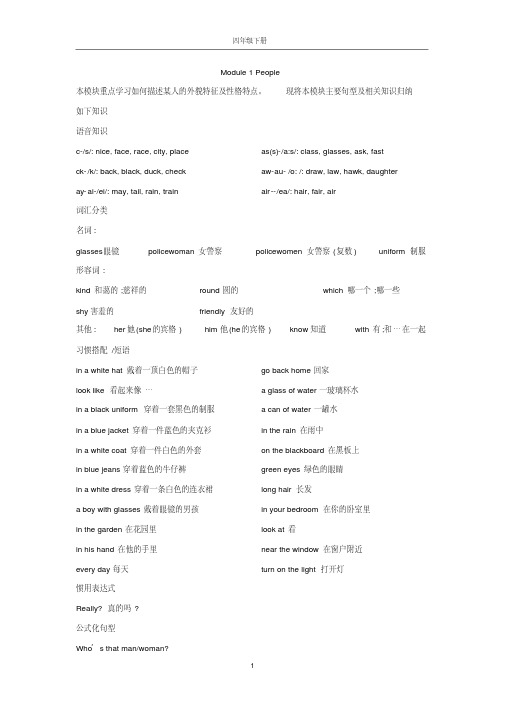
o-/A/: come, son, does
oo-/u/: look, book, cook
ou: house, about, count
oy-/?I /: boy, toy, joy, soy
ou-/A/: young, country, cousin
old -/ould/:old, cold, sold
4
四年级下册
询问对方在某一天通常做什么的句型及其答语 What do you usually do on Monday/children I/we go to the park/play games/have a trip.
’ s day/may day?
Module 4 Activities 本模块重点学习如何问答某人正在做什么。现将本模块主要句型及相关知识归纳如下 语音知识
I see.我知道了。
询问 “几点了? ”的句型及其答语
What time is it?
It ’ s seven o ’ clock/six ten. 表达 “是做某事的时候了 ”的句型
Unit2Sheisverykind(讲义)教科版(广州)英语四年级下册
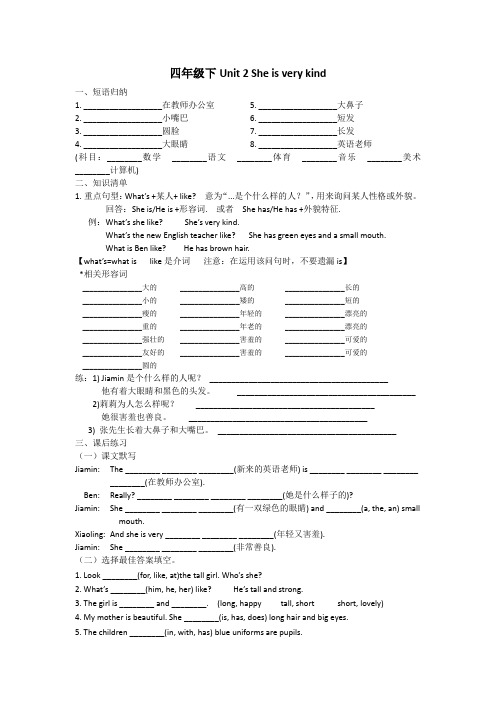
四年级下Unit 2 She is very kind一、短语归纳1. __________________在教师办公室 5. __________________大鼻子2. __________________小嘴巴 6. __________________短发3. __________________圆脸7. __________________长发4. __________________大眼睛8. __________________英语老师(科目:________数学________语文________体育________音乐________美术________计算机)二、知识清单1.重点句型:What’s +某人+ like? 意为“...是个什么样的人?”,用来询问某人性格或外貌。
回答:She is/He is +形容词. 或者She has/He has +外貌特征.例:What’s she like? She’s very kind.What’s the new English teacher like? She has green eyes and a small mouth.What is Ben like? He has brown hair.【what’s=what is like是介词注意:在运用该问句时,不要遗漏is】*相关形容词________________大的________________高的________________长的________________小的________________矮的________________短的________________瘦的________________年轻的________________漂亮的________________重的________________年老的________________漂亮的________________强壮的________________害羞的________________可爱的________________友好的________________害羞的________________可爱的________________圆的练:1) Jiamin是个什么样的人呢?_________________________________________ 他有着大眼睛和黑色的头发。
广州教科版四年级下册英语全册知识点归纳
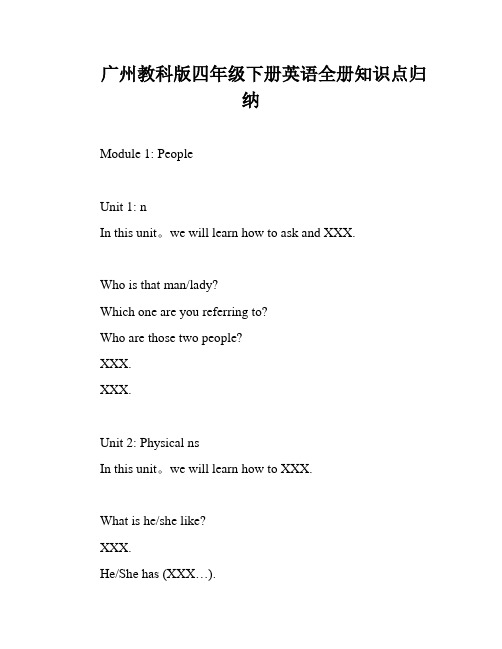
广州教科版四年级下册英语全册知识点归纳Module 1: PeopleUnit 1: nIn this unit。
we will learn how to ask and XXX.Who is that man/lady?Which one are you referring to?Who are those two people?XXX.XXX.Unit 2: Physical nsIn this unit。
we will learn how to XXX.What is he/she like?XXX.He/She has (XXX…).XXX…).Key Points:1.We have XXX rules for words containing "c," "-ck," and "-as(s)."2."In" XXX。
while "with" XXX presence.3."Which" is used XXX "what" XXX.4.We have learned subject names for subjects such as Chinese。
maths。
English。
music。
art。
PE。
and science.5.Note the differences een subject pronouns。
object pronouns。
and possessive pronouns.Please note that object XXX:Show me your books。
please.This book is for him.Module 2: Daily RoutineUnit 3: What Time Is It?In this unit。
- 1、下载文档前请自行甄别文档内容的完整性,平台不提供额外的编辑、内容补充、找答案等附加服务。
- 2、"仅部分预览"的文档,不可在线预览部分如存在完整性等问题,可反馈申请退款(可完整预览的文档不适用该条件!)。
- 3、如文档侵犯您的权益,请联系客服反馈,我们会尽快为您处理(人工客服工作时间:9:00-18:30)。
教科版四年级下册英语知识点归纳Module 1 People一、基本目标Unit1*Who’s that (man/ lady)?Which one?Who are those two persons?They’re my parents.The one with a yellow hat.(有*号的是以前学习过的句型,以后同。
)Unit 2What is he/ she like?She is lovely but shy.*He/She has (long hair / big eyes/…).*He/ She is (tall / thin/…).二、重难点分析1、下面是以前学过含有本模块总结的读音规则的词:c: nice, face, mice, science. ck: back, duck, black, sock, clock, jacket, chicken, blackboardas(s): class, glassesau/aw: drawair: hair, chair2、本课的“in”在句子里有“穿着、戴着”的意思,,表示衣着方面的特征;”with”则有“有、带有”的意思,翻译时比较灵活。
例句:The girl in a pink dress in my cousin. 穿着粉红色连衣裙的女孩是我的表姐妹。
The man with glasses is my new English teacher. 戴着眼镜的男人是我的英语老师。
3.Which的用法跟what相似,看下面的例句:Which is your pencil?Which clothes do you like best?4.表示学科的单词我们学过有:Chinese, maths, English, music, art, PE, science。
5.对比下面代词的主格和宾格和所有格:主格I you he she it we they宾格me you him her it us them所有格my your his her its our their注意主格与宾格用法的不同,宾格一般用与动词后面或介词后面,如:Show me your books, please.This book is for him.6. 注意art, English, old, eye, ear等词前用an表示一个、只、条、..., 而不用a, 例如:an art teacher, an English teacher, an old man,an eye, an earModule 2 Daily routine一、基本目标Unit 31) What time is it?s seven thirty.It’2) It’s time for breakfast/ to have breakfast/3) It's time to go to sleep4) *Let’s go to school.Unit 41) We get up at (eight o’clock).2) We have lessons from eight in the morning to four in the afternoon.二、重、难点分析1、下面是以前学过含有本模块总结的读音规则的词:g: good, grape, grow, gardeng: gym, orange, largeea: head, heavyey: they, greyer: mother, teacher, farmer, driver, writer, painter, reporter, sweater, number, mother, father, sister, brother, computer, winner. grandmother, grandfather ear: ear, near ear: bear, pearere: here ere: there, where2、It’s time for 后面跟名词,而It’s time to后面跟动词,如:It’s time for bed/ school/ class/ breakfast/ lunch/ dinner。
It’s time to get up/ go to school/ have breakfast /have lunch /have dinner/ go to bed / ...3、tired不能用作动词,要与be或look(s) 连用,如:I’m very tired. She looks tired.4、表示时间有两种基本的方法:倒读法顺读法seven (o’clock) Seven (o’clock) 七点five past seven seven oh five 七点零五分ten past seven seven ten 七点十分(a) quarter past seven seven fifteen 七点十五分twenty-five past seven seven twenty 七点二十分half past seven seven thirty 七点三十分twenty-five to eight seven thirty-five 七点三十五分(a) quarter to eight seven forty-five 七点四十五分ten to eight seven fifty 七点五十分5、from...to...是“从......到......”的意思,如:From seven am to eight pm 从早上七点到晚上八点,from one to one hundred 从一到一百6、am(a.m.)表示“上午”, pm(p.m.)表示“下午”。
7、注意时间与介词的连用:at seven (o’clock), at half past fivein the morning, in the afternoon, in the evening, at night8、用数字表示时间, 小时与分钟见可以用“:”号或“.”号。
即可写成:7:30或7.30Module 3 Days of the week一、基本目标Unit 51) What day is it today?Is it Monday?It’s Sunday.2) What’s your favourite day?/ Which day do you like best?Unit 61) What do you usually do (after school)?*2) Do you usually/ often/ sometimes (take exercise on Monday)?二、重、难点分析1、下面是以前学过含有本模块总结的读音规则的词:tr: tree, trousers (注意区别于ch和ts的发音)dr: draw, drive, driver, hundred (注意区别于g和j的发音)nk: pink, thank,wr::wrong, write, writeri: hi2、周日的名称可以缩写:Sunday--Sun. Monday--Mon. Tuesday--Tue. Wednesday--Wed.Thursday--Thur. Friday--Fri. Saturday--Sat.3.用favourite可以引出下面的句子:What’s your favourite day/ sport/ colour/ subject/...4、日期与与介词的连用常用on (表示在......日或某天的一部分),如:。
对比:on Sunday, on Saturday morning, on Wednesday afternoonat six o’clock, at half past tenin the morning, in the afternoon, in the evening, at night, at noon5、Like 有两种意思,一是“喜欢”,二是“象”:I like reading. 我喜欢阅读。
I want to be a painter like my father.课本里的句子:I always help me father do housework? 我总是帮助我的妈妈做家务。
Like what? 比如说帮什么?6、英语中表示频度的副词有:always(总是)-usually(通常)-often(经常)-sometimes(有时)-seldom(极少)-never (从不)这些词长放在在行为动词的前面或be动词的后面,如:I always help my parents after school. I am always here on Sunday.有时放在句前或后面,如:I go there very often.Sometimes I go shopping with my parents.7、两个动册间后一个动词通常用不定式to (d0)..., 如:I want to buy a T-shirt. I like to play music. I use this pen to write.但help后一般不加to, 如:I usually help mum do housework.8.He / She likes doing sth. something一般指某种事情He likes to do sth. Something一般指具体的事情9. help sb (to) do sth. 可省toModule 4 Activity一、基本目标Unit 7*1) What do you often do on Sunday/ Saturday// after school; when you have free time)?I often listen to music/ play computer games, have sports/…*2) Do you always watch TV in the evening?Yes, I do. No, I don’t.3)Shall we (watch a cartoon)Unit 81) What are you doing?I’m reading / playing computer games.2) Are you playing computer games?Yes, I am./ No, I’m not.二、重、难点分析1、下面是以前学过含有本模块总结的读音规则的词:o: come, does, love, front, Mondayou: house, mouse, mouth, blouse, trousers, playgroundou: young, touchoo: too, pool, schooloo: cook, book, look, goodoy: boy, toyold: oldoor: door, floor2、注意:an interesting book (用an, 不用a);3、one of you 你们中的一个人的意思。
